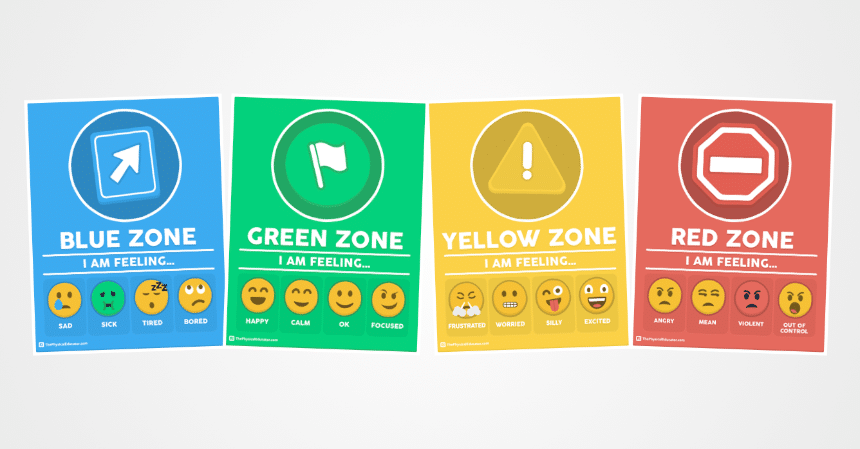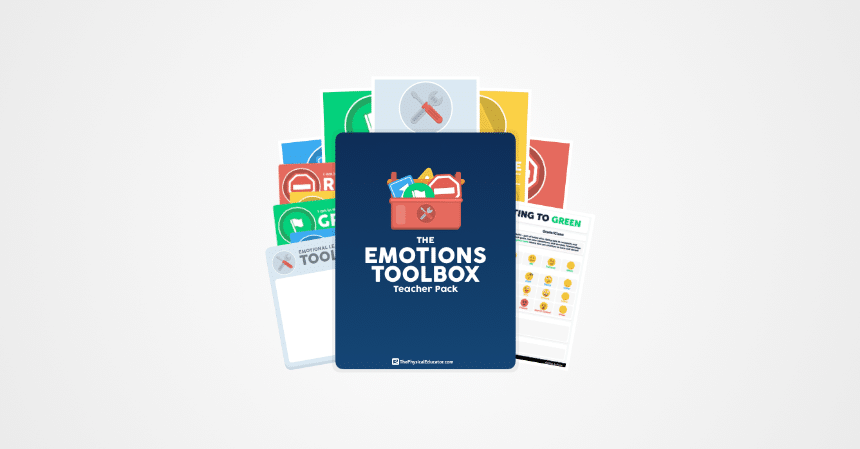The Emotions Toolbox: Self-Regulation In Physical Education
A while back, I saw a tweet from Jorge Rodriguez in which he shared how his kindergarten students were unpacking emotional well-being in his physical education class.
https://twitter.com/PhysedNow/status/1087756202757500928
The resources he was using reminded me of a tool we had developed at my school called the emotional wheel.
https://twitter.com/JoeyFeith/status/1087911135733518337
I made that graphic along with some colleagues for a lesson that would live within my school’s K-11 CORE 5 curriculum, a program designed to help students develop resiliency.
The idea for the lesson was as follows:
We worked really hard on that lesson and successfully introduced it to the students that year. That said, despite knowing there was some power to the lesson and its resources, I could never figure out how to make it fit within my every day PE lessons and the emotional wheel quickly got moved to the back burner.
When I saw Jorge’s tweet, I started thinking about that emotional wheel and shared it with a colleague at school: an Aussie guy by the name Karl Mercuri (who has been working at my school since the start of the year). I knew that Karl had been providing professional development to local school boards on social and emotional learning, so I was curious about what he thought of our original lesson. That’s when Karl introduced me to a system that was incredibly similar to what we had built, but more more elegant in regards to how it can live within a school’s every day reality.
Before we get into that, let’s take a look at the “WHY” of emotional self-regulation:
In layman’s terms, emotional self-regulation is an individual’s ability to manage their emotions so as to avoid spending too much time in emotional, reactive states. This form of emotional management allows us to act in accordance with our values and beliefs rather than emotionally react to external stimuli in ways that do not represent who we are as people.
So, why is this important for students? Well, when students are able to self-regulate their emotions, they are in a better position to be able to direct their efforts towards a goal and can achieve this despite changing/challenging situations. Emotional self-regulation helps students develop resilient attitudes and primes them for learning and success. Most importantly, it empowers students and allows them to become functioning, contributing members of society.
Just like academic or physical skills, emotional self-regulation skills can be taught. However, in order to achieve this, we need to approach the teaching of emotional self-regulation with purpose and intention.
The good news is that there exists a framework to achieve just that! It’s the one that Karl introduced me to and the one that I have adopted for my physical education program to provide a layer of emotional self-regulation education to each of my lessons.
Let’s take a look at the Zones of Regulation:
The Zones of Regulation is a framework that helps foster self-regulation and self-control. The framework’s curriculum activities are designed to help students recognize when they are in different emotional states (i.e. “zones”) and provides students with tools that will help them to either remain in a zone or move from one zone to another.
The four zones of the Zones of Regulation framework are as follows:

Leah Kuypers, the creator of the Zones of Regulation framework, shares the following four principles that are essential to keep in mind when implementing the zones:
Before I get into how I will be using the Zones of Regulation in my physical education program, I want to recommend that you check out the framework’s book. The resource is packed with lessons and activities that can be picked up and introduced in school. When I was talking with Karl, we were discussing the importance of having the framework live in all aspects of school life so that students can transfer and apply their learning to a variety of contexts. When I was talking about it with other colleagues at work who have been exploring the Zones of Regulation, they all agreed that the book’s resources were simple to implement and led to engaging learning experiences for their students.
Side note: I’m in no way affiliated with the Zones of Regulation and this is not a paid promotion. I just really appreciate when someone puts in the work to create something great for teachers and want to make sure I give proper credit.
Based on the Zones of Regulation framework, I designed a few resources for use in my PE program. My intention with these is to bring a layer of emotional self-regulation skill-development to every PE lesson. By having the system set up in my gym, we can easily use it as a tool to reflect on our emotional states and as a lens through which we can make sense of the emotions we are experiencing as we learn in physical education.
My long-term goal is to bring this to other settings within the school (e.g. classrooms, cafeteria, recess yard) so that, as I mentioned earlier, students can transfer and apply what they have learned in regards to emotional self-regulation in different situations throughout the school day.
Here’s how the framework lives in my program:

The first step is to introduce the four zones to my students. Again, it’s really important that we don’t tie any judgement to any of the zones: if students feel bad or guilty about being in a zone, that can prevent them from being able to reflect objectively and apply tools/strategies to move to green.
To help introduce the zones to my students and to help keep them front and centre in my lessons, I made the student-friendly posters that you can see above. Each poster shares four possible feelings that are associated to the poster’s zone. When I introduce the zones to my students, I also invite them to name other feelings that may live within each zone so as to ensure that students have a clear understanding of the zones.
These posters will continue to live in my gym so that they can be referenced throughout our lessons. When I feel that a lesson is becoming highly emotional (which happens), I want to make sure to give my students an opportunity to step out of the situation and make sense of what is going on by referring back to the zones posters. Helping the class become aware that, as a group, we have moved out of the green zone and allowing students to recognize and name their feelings will put us in a better place to be able to reflect on what tools we can use to move back to green.

To serve as a reminder of potential tools/strategies to help students move from one zone to another and to kickstart our group reflection on some of their favourite tools, I also made the Toolbox poster.
The poster reminds students that - in order to be able to learn and thrive in PE - we want to get ourselves to (or keep ourselves in) the green zone. It also provides students with ten simple tools that they can use. These tools were some of the ones we identified way back when in our CORE 5 lesson.

As I mentioned earlier, the toolbox poster is just a start: I want students to be able to take ownership of their own emotional toolboxes. To do so, I’ll invite my students to reflect on tools/strategies that work for them and share these with their classmates by completing and displaying a Toolbox Card.
I’m always amazed at what my students come up with and at their ability to put things into terms that I wouldn’t ever think of using but that make TOTAL sense to their peers.

I want to be able to provide my students with a simple and quick way to check in on their emotions throughout our lessons. I especially want to know how they are doing at the start of a lesson so that I can adapt my approach in how I teach them that day.
Since we already use assessment magnets in class and it is a system the students are familiar with, I decided to create the Zone Tags you see above for my whiteboard.
The idea is that students, upon entering my gym, will be invited to quickly check in with their emotions and then place their magnet underneath the zone that they are in. At any time throughout the lesson, students can move their magnet if they feel that they have changed zones.

A few things to note:
Although I have the Plickers codes on my magnets, I have no intention of scanning students results. The check in is for students’ personal awareness and not for assessment purposes.
If you’ve never used an assessment magnet system before, then you should know that it is not overly obvious whose magnet is whose. Students would need to know the other students’ magnet numbers, which isn’t usually displayed unless the students forgot their number. That being said, I had a conversation with Karl about having this check in be publicly displayed on the board. We agreed that there are advantages to it being so:
With all of that said, students may feel uncomfortable displaying their zone level or may be influenced to report an incorrect zone based on feeling pressure to be “ok”. To counter this, I’m making the check-ins optional for my students: they don’t need to place their magnets should they not wish to do so. If I see students who have opted out, that gives me enough information to know that I should try to connect with that student at some point in the lesson.

The last part of this system involves a student support sheet that can be used by students who are having a hard time identifying which zone they are in, need to talk about how they are feeling, and are looking for a tool to get them to the Green Zone.
The support sheet I designed is there for when I recognize that a student needs additional structure for their reflection. As much as I wish I could give every student all of my time and attention, it can be difficult to do so mid-lesson (especially without it having a negative impact on the learning of that student’s classmates).
The “Getting To Green” support sheet is there to help the student:
Again, this sheet is not a consequence for bad behaviour nor is it a piece that will be held against them during grading: it is simply an additional support tool to help them develop their self-regulation skills.
If you’re interested in implementing this system in your physical education program and would like to access the visuals I made for my own gym, you can find them all in the Emotions Toolbox Teacher Pack

Download The Emotions Toolbox Teacher Pack
This Teacher Pack includes:
I hope that you've found this post and the resources I shared in it useful! If you have used the Zones of Regulation (or something similar) in your teaching, I would love to hear about your experience! Feel free to share in the comments below.
Thanks for reading and happy teaching!
